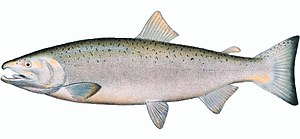Environment Fishery
A number of media outlets in Alaska are reporting that at today’s meeting of the International Pacific Halibut Commission, scientists have said that the population can only sustain harvest quotas at half the current level.
The story comes mainly from the Kodiak Daily Mirror, with additional information from other media outlets. There is currently no news release on the IPHC website.
The Associated Press, quoting the Mirror, says:
Biologists say without adjusting for past overestimates, 2012’s Pacific
halibut limit would be set at 33 million pounds, down from 41 million
pounds in 2011. If an adjustment was made for past overestimates, the
sustainable catch limit may be as little as 15.3 million pounds across
the entire North Pacific.Biologists do not know why their estimates have been consistently too high
Station KSTK, an Alaska Public Radio station is saying that the IPHC wants a 13.3 per cent cut in British Columbia’s quota to 6,633,000 pounds.
Alaska Dispatch says halibut harvest levels could go down to levels not seen since the 1930s.
The news website says: “Adult flatfish are disappearing from the population at unexplainable rates…”
Alaska Dispatch quotes IPHC biologist Steven Hare as saying that the real problem is “unspecified mortality.”
Halibut are disappearing from the population for reasons managers can only guess at. “It’s troubling,” Were managers to take these mystery disappearances fully into consideration, he added, they would be forced to recommend drastic cuts in commercial harvests.
One model that does this, he said, suggested setting catches “28 percent lower than the lowest level since 1935.” Catches, or at least legal catches, have already been pushed down 55 percent in the past decade, and they are for sure going down again
Proposed quotas according to KSTK
The staff’s 2012 catch recommendations for each area include:
- 989,000 pounds in the Pacific Northwest area 2A which is up 8.7%.
- 6,633,000 pounds in British Columbia area 2B which is down 13.3%.
- 2,624,000 pounds in area 2C which is up 12.6%.
- 11,918,000 pounds in the Central Gulf Area 3A which is down 17 %.
- 5,070,000 pounds in the Western Gulf Area 3B which would be a drop of about 32 %.
- 1,567,000 pounds in the Aleutians area 4A which is down about 35 %.
- 2,180,000 pounds in the Aleutians area 4B which is 14 % down.
- And 2,465,000 pounds in the Bering Sea areas 4C, D, and E a reduction of about 34 %.
The board will make a final decision on 2012 catch limits at a meeting in Anchorage from Jan. 24-27.




 The United States National Marine Fisheries Service has extended the deadline for comments on its controversial Halibut Catch Sharing plan by 15 days until Sept. 21.
The United States National Marine Fisheries Service has extended the deadline for comments on its controversial Halibut Catch Sharing plan by 15 days until Sept. 21.